Playing the guitar is not a piece of cake. But, if you know What Are The Notes On A Guitar, you can play all the chords, riffs, and solos with ease!
In the meantime, don't forget to unlock a world of unlimited sound with Amazon Music Unlimited, where over 100 million songs wait at your fingertips. Whether you're working, relaxing, or fueling your creativity, the right track is always just one tap away. Elevate every moment with music that moves you.
Playing the guitar is not a piece of cake. But if you know the notes on the fretboard, you can play all the chords, solos, and riffs you want with ease. So, it’s evident to know about all the notes before getting your hands on a guitar. The question to ask right now is, what are the notes on a guitar? Let’s answer.
Read Also
- Best Acoustic Guitars Under 100
- Best Acoustic Guitars Under 200
- Best Acoustic Guitars Under 300
- Best High-End Acoustic Guitars
- Best Electric Guitars Under 200
- Best Electric Guitars Under 300
- Best Electric Guitars Under 500
- Best Bass Guitars Under 200
- Best Bass Guitars Under 500
- Best Bass Guitars Under 1000
What will we learn today?
Before answering that, let’s find out what you will learn in this article. We will discuss the
- Notes on the guitar.
- Alphabetic names of notes.
- Difference between notes and
- Easiest ways you can remember the notes.
- About sharp and flat notes and much more!
So, without any further ado, let’s proceed with today’s lessons.
Why Do I Need To Learn The Notes On A Guitar?
If you want to be able to play guitar well, it is essential that you learn the notes on the instrument. Why is this? There are a few reasons:
1. If you don’t know the notes, you won’t be able to create melodies or chords. In order to create music on the guitar, you need to be able to combine different notes together.
2. Knowing the notes will allow you to communicate better with other musicians. If you’re playing with others, they will need to know what note you’re playing in order to follow along.
3. It will make reading sheet music easier. If you can’t read the notes on the page, you’ll be at a disadvantage when trying to sight-read or learn new songs.
4. You’ll have a better understanding of the guitar’s fretboard. The fretboard is the area of the guitar where the strings are placed. If you don’t know where the notes are, it will be difficult to find them when you’re trying to play.
5. It will make learning new techniques easier. If you know where the notes are, you’ll be able to learn new guitar techniques.
Overall, learning the notes on the guitar is a necessary step for any serious musician. By taking the time to learn them, you’ll be setting yourself up for success in your guitar playing.
Do I Need To Learn All Of The Notes On Every Guitar String?
This is a question that often comes up among guitar players of all levels, from beginners to experienced players. The simple answer is no, you don’t need to learn all the notes on every string. However, there are some good reasons why learning at least some of the notes can be very beneficial.
One reason is that it can help you to better understand the fretboard and how the notes are laid out. If you only know the notes on one string, it can be easy to get lost when trying to find a particular note on another string. Knowing the notes on all the strings can help you to more easily navigate the fretboard.
Another reason is that it can help you to better understand chords and how they are constructed. If you know all the notes on the fretboard, it is much easier to see how chords are made up of different combinations of notes. This can be a big help when trying to learn new chords or figure out how to play a particular chord voicing.
So while you don’t need to learn all the notes on every string, there are some definite advantages to doing so. If you’re just starting out, you may want to focus on learning the notes on one or two strings at a time. As you become more comfortable with the fretboard, you can start adding in more strings until eventually, you know them all!
What Are The Guitar Strings?

The process of knowing guitar notes starts with knowing about guitar strings. So here we go.
Most guitars have six strings. The string on the top is the thickest one. The order is from top to bottom, thick to thin. But the numeric name of the strings is not according to the top to the bottom formation or position.
Instead, the thickest string is called the 6th string.
Read Also
That means the string on the top which you might consider as the first one, is actually the 6th string of the guitar.
The first string of any guitar is considered the last one from the top, the thinnest string of any guitar. So, the formation of any guitar is from thick to thin top to bottom. But on the other hand, if we go numeric, the numbering is from bottom to top 1st to 6th.
So, now we know what the strings are called in numeric order. Now, let’s get acquainted alphabetically.
Alphabetic Names Of The Guitar Notes
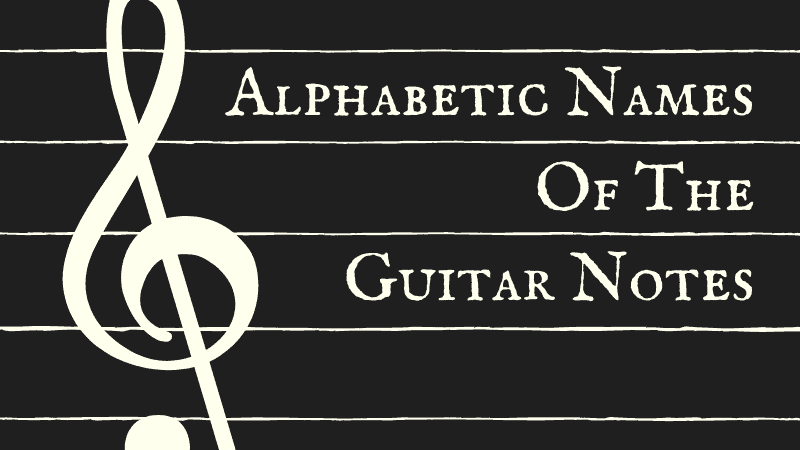
If you have already started taking your guitar lessons, you must have heard the alphabetic names of the guitar notes. But the problem we face is while remembering about them.
It’s easy to remember that there are five names of the notes that are divided into six strings.
What we don’t know is why the strings are called by that name. So, in this part, we will not only know the names but also will know why the names are assigned that way.
According to the standard tuning procedure, the strings are given alphabetic names. That means the alphabetic names you see are actually the tuning of the string.
The 6th string means the thickest string of every guitar is tuned at E. So, it’s called the E string. But there are two E strings on a guitar. Which one is it?
The 6th string delivers a deep and low sound. That’s why it’s called the Low E String.
The 5th string is adjusted to A, so, it’s called the A string.
Next is the 4th string which is adjusted to D that’s why it’s called the D string.
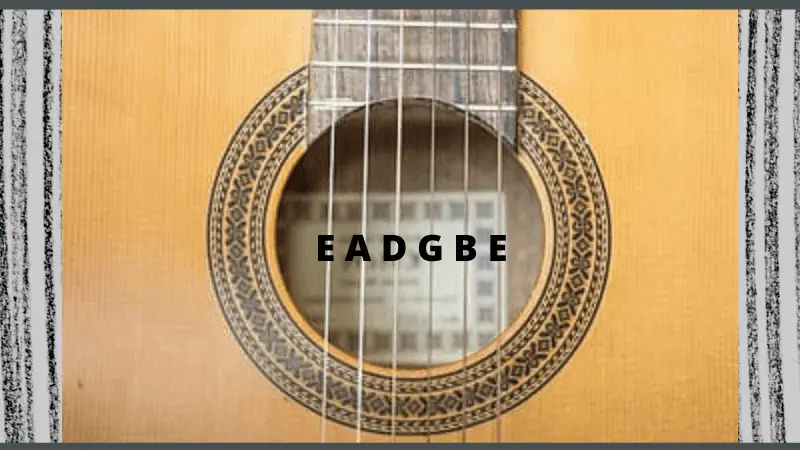
Then comes the most controversial one, the G string. The 3rd string might have a very catchy and controversial name. Maybe that’s why it’s the most used one on the guitar.
The 2nd string is adjusted to B, so it’s called the B string.
And finally, the thinnest one. Just like the 6th string, it’s also adjusted to E, but the string produces a very high-pitched sound. That’s why it’s called the high E string.
So, E, A, D, G, B, E is the order to remember.
Note here that when you are strumming the open strings from top to bottom in standard tuning, E, A, D, G, B, and E are the exact notes that you are playing in your guitar.
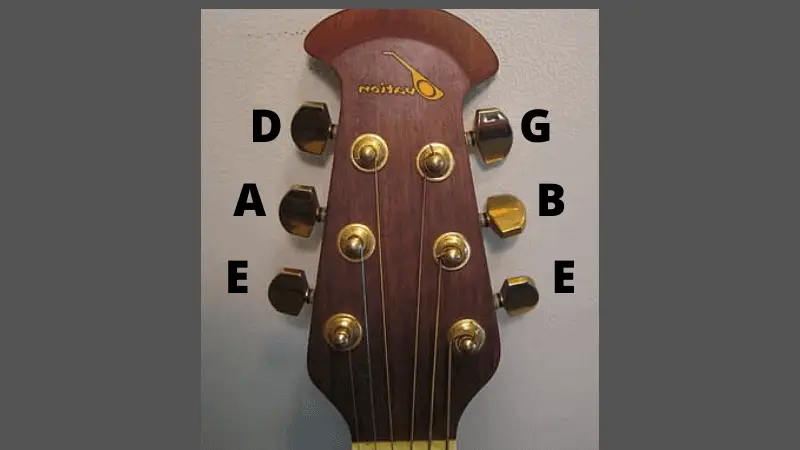
We’ll discuss more on open strings. Keep going!
Fun Ways To Remember The String Names
Yeah, it might seem that you’re only to remember the five strings’ names, how can it be hard? The problem is that your guitar lesson does not end with the string names only. It goes on and on. You have to know about the flat ones and the sharp ones, you have to know the chords, and you have to know about the 12th fret including other 20+ frets on the fretboard.
So, coming up with a funny mnemonic to remember the strings is how you can make the learning process fun.
There are two famous ways of remembering the string names. The first one is
Eddie Ate Dynamite, Good Bye Eddie.
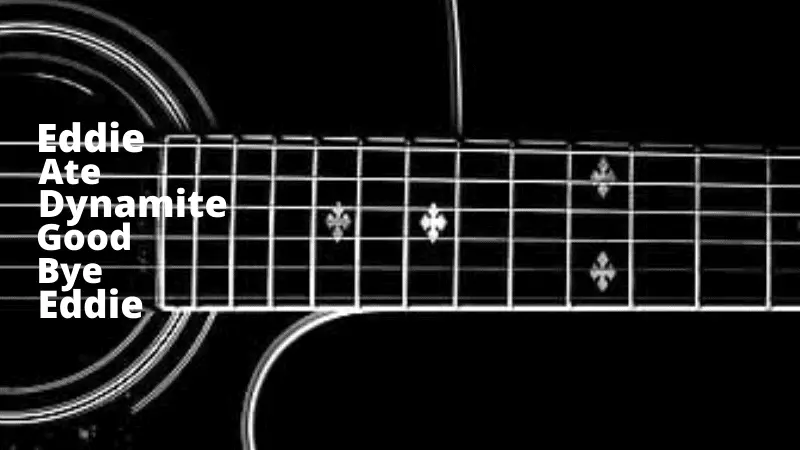
The order is maintained from thick to thin.
Another one is Every Boy Gets Dessert After Easter.
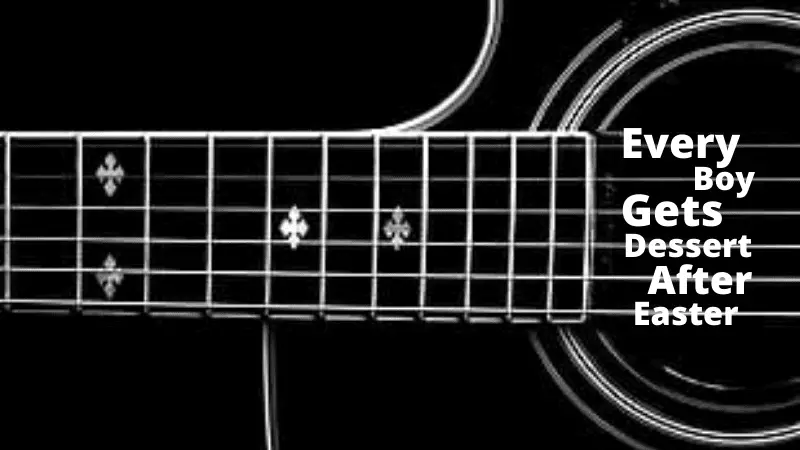
Here the order is maintained from thin to thick.
These two are the most common ones people learn to start their guitar lessons. Mainly guitar instructors teach them their favorite mnemonic.
We would suggest that you come up with your own funny mnemonic. If you can do so, it’ll be your own creation. That would be something exceptional, isn’t it? And funny because if you can make your learning experience even more fun by adding one funny mnemonic, you might as well do that because guitar lessons get harder over time.
The names according to the tuning suggest that these are open strings. This means without holding any fret and note on the fretboard if you stroke a string, it will produce the sound of a specific tune. That’s why the names suggest open strings tunes.
Difference Between Notes And Chords
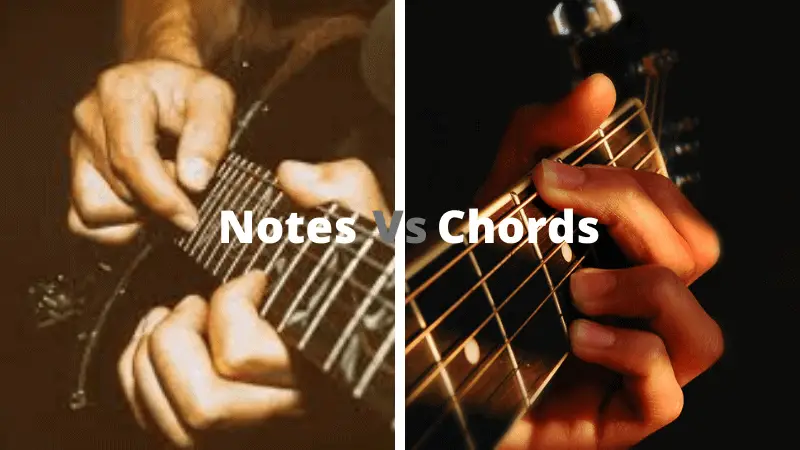
Sometimes beginners confuse themselves with notes and chords. While we play the guitar, whether it is acoustic, bass, or electric, we depend on the notes, but we play the chords.
Still, confused? Well, you won’t be anymore. A chord basically is the combination of several notes held together to create the perfect sound. Most songs played on a guitar are not played on notes; they are played on chords.
Several notes make one chord. Let’s go through some fundamental differences to understand better.
- A chord is a group of sounds played simultaneously while a note is just a single sound of one string.
- Notes contribute to the chord, and a chord creates a melody.
- Chords usually are created by the 3rd, 5th, 7th, 9th, and 12th fret holding other tunes accordingly.
- The note cannot be played in inversion, but chords can be.
- Notes are used to denote the pitch and duration of a sound; chords denote harmony.
These are the fundamental differences between chords and notes. Definitely, you have to learn notes before you can specialize your way in chords. No matter how well you know your chords, if you don’t know your notes, you won’t be able to create any simultaneous harmony to play a song.
Musical Alphabet
While the normal alphabet goes from A to Z, the musical alphabet goes from A to G.
Now here’s an issue. When we hear about sharps and flats, it creates a dilemma that would be something really hard to capture. But it’s not true.
Basically, all we have to remember are some symbols and signs to get acquainted with sharp and flat notes. The rest we can do while playing the actual guitar.
So, the alphabetical order for musical alphabets is – A, A#, B, C, C#, D, D#, E, F, F#, G, G#, A.
The # sign represents the sharp notes. Now for the dilemma.
Are Sharps And Flats Different From Each Other?
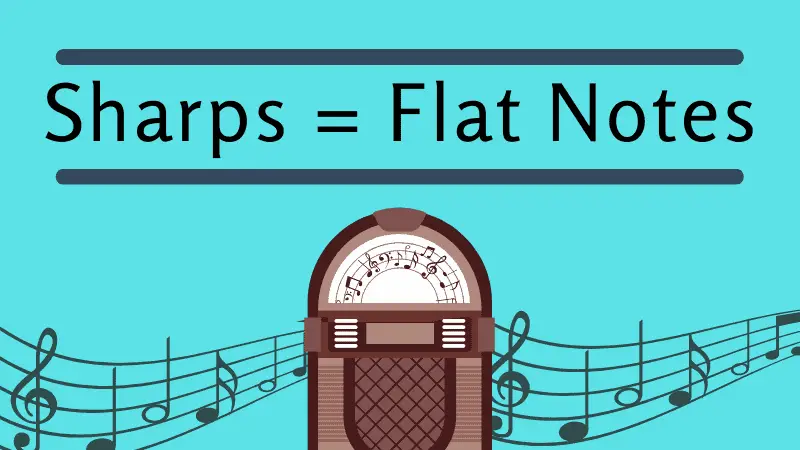
The answer is no. The sharps and flats are technically the same things. Flat notes are – A, Bb, B, C, Db, D, Eb, E, F, Gb, G, Ab, A.
You can see that in the previous line where we introduced the sharp notes, here, A# is replaced by Bb. So, sharp notes and flat notes are basically the same things.
# represents sharp, and ‘b’ represent flat.
Usually, when a chord is written using notes, you’ll see a mixture of sharps and flats.
Not all the notes have sharps or flats. There are some notes they remain natural. Now the real question occurs, why do we need sharps or flats?
As you can see, the note that is sharp for A is flat for B. To keep the chords simple and easier to understand, and accordingly, we require to know what note is flat for which natural note and what note is sharp for which natural note.
That’s how the chords are kept simple and easy.
Practicing Notes
The fretboard of a guitar is where you hold the strings with the board to achieve a specific note while strumming. Each gap on the fretboard represents a specific note for every string.

Usually, there are fret markers that mark the 3rd, 5th, 7th, 9th, and 12th fret for ease of playing the guitar.
When you’re not holding a fret, it’s called an open string, and it’s counted as 0. Then you hold each fret up till 12. It’s called going up.
Why? Because the more you go towards the frets of the guitar body, the higher the pitch of the sound becomes. So, the idea is going up the fret while you’re actually kind of moving down toward the body of the guitar.
What’s A One-Half Step?
While playing the guitar, you don’t always hold the exact notes. Sometimes you hold the interval part between each note to create a specific type of note for creating a chord.
Holding notes on the interval of two notes is basically known as a one-half step.
The one-half step is not a fundamental term, yet it is very important. Because sometimes there are chords that will make you tap between intervals of two notes to create the perfect sound. That’s when you will have to know what a one-half step is.
As a beginner, you don’t have to practice that. For now, it’s just a theory that you have to remember for the future when you will learn alternative tuning and more complex chords. Especially while trying guitar solos.
Final Words
Playing the guitar precisely is not easy work to do. It requires a lot of passion from within to learn how to play the guitar properly and feel the music. When we see professional guitarists and bands on stage on the action, it gives us thrills and makes us wonder when would we be able to play the guitar like that.
We should remember, those rock stars with guitars who make us feel like the guitar is a part of their body also started with these basic steps way back in time.
So, you’re starting today as a beginner with basic knowledge and tips, later on, you, one day will surely be able to rock a guitar like a rockstar and put everyone on their heels with the magical sound you’ll produce with your guitar.
Start from knowing the notes, and get ready to rock the chords eventually.
As an Amazon Associate, Cleanestor earns from qualifying purchases at no additional cost to you.

